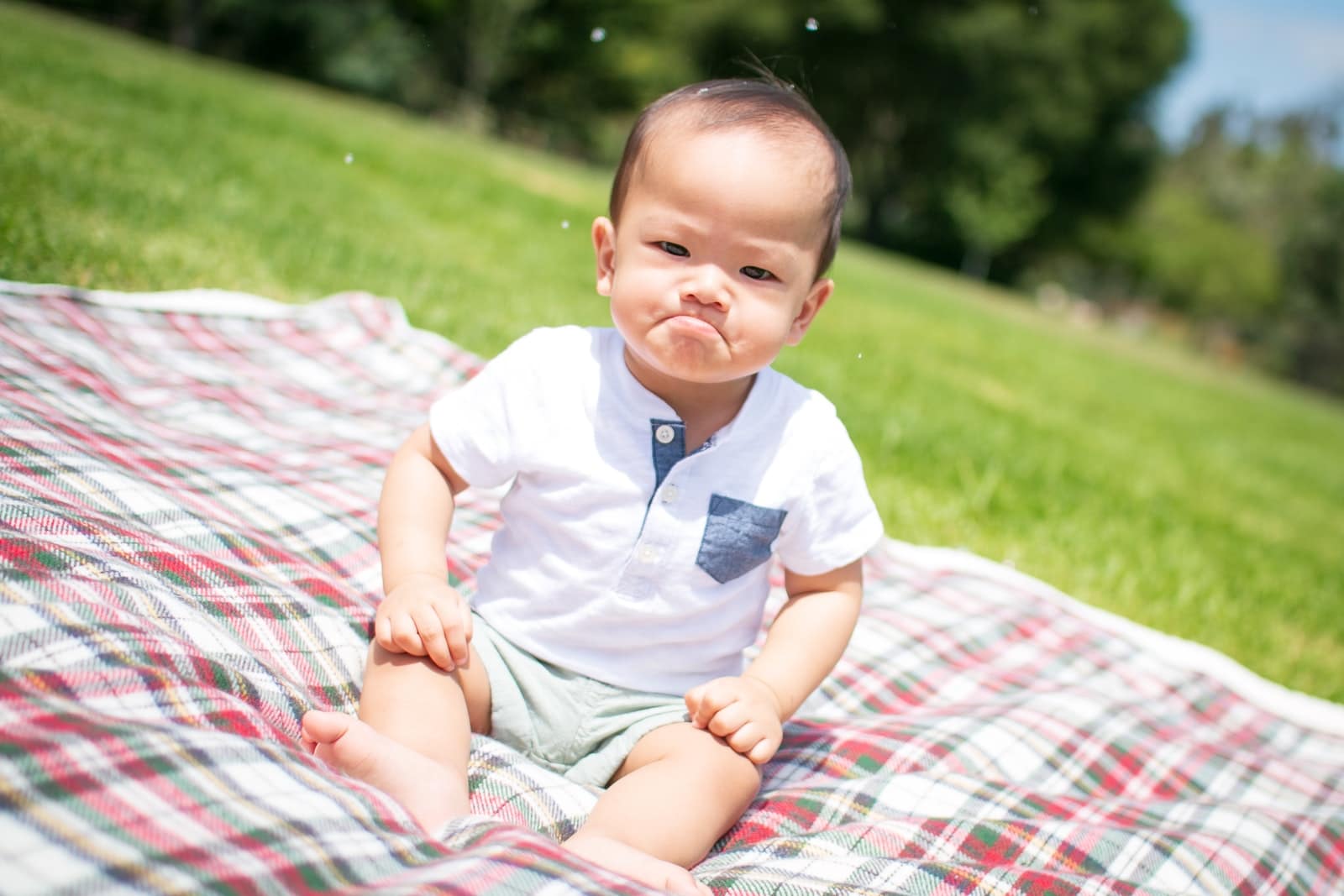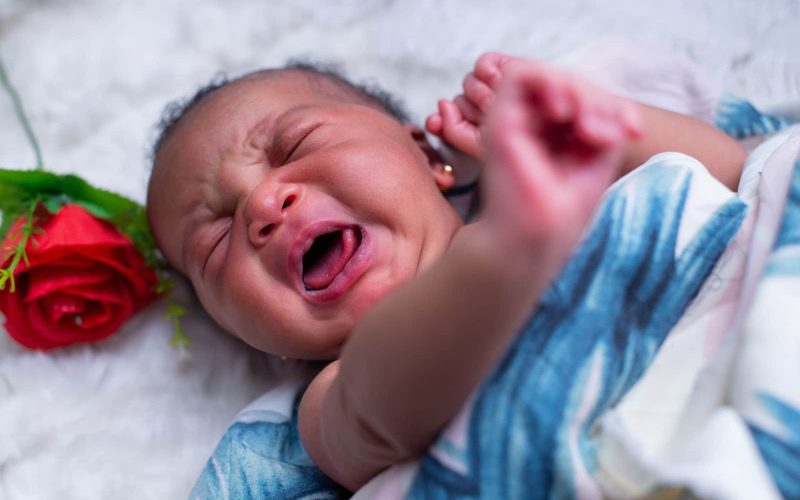When your little one first came into the world, he probably cried to announce his arrival.
They didn’t just mean a hello! A baby crying at birth is how their lungs start to work.
They make many baby cries, from giggles to grunts to babble. Most of the time, they are happily absorbed in their new world.
While it might have been music to your ears when you first heard it, watching your baby cry every day and not knowing why can be upsetting even for both of you.
Although your baby can’t talk, she can give clues to help you figure out what she’s communicating.
Unable to tell you exactly what she needs in words, she relies on various whimpers, cries, and screams to get your attention.
It can be difficult for new families to understand each crying sound. You’ll be relieved to learn that babies have their language; oddly enough, it’s the same no matter where your baby is born.
It’s a universal language for babies; the good news is that you can pick it up easily.
Of course, practice makes perfect; over time, you will become more familiar with what they are trying to tell you.
Until then, we will help you translate the different types of baby cries. But before we get into that, let’s first go through why babies cry in the first place.
Why Do Babies Cry?
The first few weeks after the birth of a newborn can be stressful for families as they try to find out why their newborn is crying.
The different types of baby cries express a baby’s different needs or emotions.
While it may be natural to crack the code for certain types of crying, most new parents need little support.
Parents of babies need to take care of themselves during the first weeks of having a baby.
When you are healthy and calm, you have more energy to foster a meaningful relationship with your child and present a positive role model from which your baby will learn as you respond to their different types of cries.
Here are some “crib” notes to help you understand what your baby might say (or cry out)
8 Reasons Why Your Baby is Crying
1. Your baby has a dirty diaper
Babies cry a lot in the first few months. There are many baby cries, but your baby will tell you when he has a wet or full diaper.
Wet or dirty diapers are one of the main reasons babies feel uncomfortable. No one wants to wear a full diaper longer than necessary.
Watch out for A persistent, nasal, whiny cry with a short crying sound followed by a longer one. When the sounds turn into loud cries, it’s a sign that the baby is fed up. Check for a full or dirty diaper.
2. Your baby is hungry
This type of crying is associated with breastfed and bottle-fed babies. It may have a slow introductory phase, during which the baby wakes up and realizes it is hungry.
At first, it may sound like restless crying, but after a while, it becomes more frantic as it gets louder, longer, and more demanding.
Watch out for: the kind of cry that sounds like a siren. The sound is often accompanied by raising the hand to the mouth, clenching the fingers, and turning the head toward the bottle or breast.
3. You have a tired baby
Babies cry to communicate with their parents. They may cry because they are hungry, uncomfortable, or tired.
Families are advised to “watch, listen, and think about what might happen.” Then, they should respond to the baby’s cues.
During the first weeks, newborns rely mainly on their cries and reflexes to communicate.
Thus, you may notice them yawning, closing their eyes, making jerky movements, bringing their fist to their mouth, and sucking their thumb. An older baby may rub his eyes as he develops.
Watch out for loud sounds of babies crying behind which there is a lot of breathing. They often begin with short, quiet whimpers that escalate until the child’s needs are met. It is a cry that your natural senses will please and learn from.
4. You have a sick baby
It can be difficult for parents and caregivers to hear this cry, but it usually means your child is not feeling well.
You should also consider other symptoms, such as if your baby is lethargic, has watery eyes, or has a runny or stuffy nose.
Take your child’s temperature if you suspect she has a fever. Call your GP or the state helpline if you are concerned about their health and well-being.
Talk to your doctor if you suspect your baby is suffering from acid reflux (GER).
Watch out for constant crying that doesn’t stop even when the baby is fed, comforted, or put to sleep. Cries that indicate signs of illness often sound like weak, tired moans. They are usually high-pitched with low intensity. There may also be long pauses between crying.
5. Your baby is uncomfortable
This cry can happen at any time compared to the different types of baby cries, especially in older, more mobile babies.
In other words, your baby is not where he wants to be. They can move a lot in your arms, turn their head from side to side, or stretch where they want.
Watch out for A scream that sounds more like a combination of all the different types of baby cries. You can persevere until the babies get what they want. Sometimes, they can wish they were down. Another time, they may want the other person to pick them up and hold them.
6. You Have a Prestimulated Baby
When there is too much light, new sounds, or new experiences simultaneously, your baby may become overstimulated. Change their environment.
Close the curtains, dim the lights, add white noise like a fan or vacuum cleaner, or listen to recorded nature sounds to calm the baby.
Watch out for the baby’s intense crying that goes up, down, and up. This cry resembles when a baby suffers from wind or gas pain. Your child may try to turn their head or body away from distracting lights or sounds.
7. You are bored with your child
Babies use different types of baby cries to express their needs. Crying may be the only way babies communicate what they need.
However, their crying can also be caused by boredom. There are two schools of thought on boredom-induced infant crying:
- Babies seek attention by being picky and restless. Crying gets someone’s attention (“I cried, and they came!”). This often leads to someone holding the baby.
- Boring babies need to be entertained. This can lead to over-stimulation of the baby and starting to cry again.
We believe that they progress when children are encouraged to accept their curiosity and explore their environment.
Watch out for Oohs and ahhs as the baby tries to get your attention. When they fail, the cooing turns into an upset baby cry, then a bitter cry that alternates with whimpers. She has a crying pattern similar to a stimulated baby.
8. You have a colicky baby.
The reason for the high number of colic discomforts is still unknown. How much is related to excessive crying and irritable behavior of the baby is unclear.
Any particular medical condition, such as acid reflux, does not cause it. Instead, colics are persistent cries that are hard to calm. It can start when the newborn is only a few days old.
Not being able to comfort your baby can be very stressful. Parents, families, and caregivers with colic babies need to care for themselves.
Your GP can determine if your baby’s persistent crying is due to a medical problem.
However, most babies with colic have no known cause for their behavior.
Watch out for long periods of crying accompanied by intense wailing or screaming, during which your baby will be irritable, whingy, and fidgety. Most babies naturally cry for 2-3 hours a day. However, a colic baby will cry even more, especially in the late afternoon or early evening.
What if you can’t find a reason for the baby’s cry?

Some newborns’ crying does not seem to be related to basic needs. In fact, 80-90% of all babies have a 15-minute to an hour-long cry, a different type of baby cry that is difficult to explain or decode.
Most of these crying sessions happen at night. It may be the hectic and most stressful time of the day at home: everyone is tired, everyone is hungry (and the mother’s milk supply may be at its lowest for the day), everyone’s done, done, done, and it goes for the baby, too.
Or, after a hard day of accepting and processing all the sights, sounds, and other stimuli in the environment, your baby may just need to calm down with a good cry. Crying for a few minutes can even help them fall asleep.
However, if you think you hear a cry of discomfort or pain, make sure something is making your child uncomfortable, such as clothes or hair wrapped around her finger.
Call your pediatrician if your baby’s crying seems unusually long or intense and inconsolable.
Also, through extensive observations and research by specialists, several basic sounds a baby makes just before making the different types of baby cries, depending on their age, have been discovered.
The top five vocal reflexes that have been selected for review;
- Neh – hunger
- Eh – upper wind (burps)
- Eairh – lowest wind (gas)
- Heh – discomfort (hot, cold, wet)
- Owh – drowsiness
Let’s dive a little deeper into how you can interpret each of these different sounds.
This should give you a few more clues to help you figure out what the crying baby is trying to tell you.
Baby crying sounds in words;
1. “Neh” – hunger
The newborn uses the sucking reflex to create a “neh” sound when hungry. The best way to recognize this sound is to look at your baby’s mouth.
They’ve been practicing this vocal reflex in the womb. If your baby is in a sucking motion and crying, you will hear “neh” first.
Babies make this sound when their tongue moves to a position behind their teeth, similar to where we make an “nnn” sound.
When your baby opens his mouth, his tongue slides forward to suckle—combined with the air behind the cry, which creates a “neh” sound. It may sound like the word “net.”
Observation: Most newborns clench their fists when hungry (a reflex known as palm grasping). Babies may also try to bite or suck on their hands or reach for your breast or bottle.
By observing your baby’s response to hunger, you can respond to your baby before he becomes very hungry.
2. “Eh” – upper wind (burps)
The “eh” sound reflex means your newborn needs to burp. This sound is caused by internal reflexes pushing the air bubble out from their chest.
The baby responds naturally with a short hiss, grunts, or squeaking, sounding like “eh” in “egg .”This is not an actual burp but your baby’s sound when he tries to burp.
Observation: Facial expressions of pain, squirming, kicking, shaking, and other fussiness are indicators that your baby needs to burp.
You want to avoid the buildup of air bubbles. Even if they haven’t finished drinking, burping them occasionally to continue feeding would be good.
3. Eairh – lowest wind (gas)
This sound is most noticeable when the baby is between 6 and 12 weeks old. If the baby has bloating or stomach pain, you will hear the reflex sound of “eairh .” If the sound is isolated from crying, your baby may feel general discomfort and not develop severe gas pain.
“Eairh” begins with an open mouth, a folded tongue, and a taut stomach. When the pain is intense, the beginning of the “eairh” sound is prolonged until it becomes an intense cry—described as a loud, loud cry that makes parents uncomfortable. Cramps in the abdominal muscles cause it.
Observation: if you miss the first sounds and your baby starts crying, the crying will be very loud, intense, and rhythmic.
This will last until the wind passes, and it may follow a similar path to the bowel movement.
Several different holds can alleviate their discomfort, or you can massage them.
4. Heh – discomfort (hot, cold, wet)
Babies make a reflex “heh” sound when feeling stress and discomfort, such as when indicating a diaper change. This sound is associated with babies over six weeks old.
This sound is activated in response to a skin reflex, such as a feeling of sweating or itching. “Heh” has some vocal variations.
Observation: when a baby is uncomfortable, his cries are generally light and intermittent.
Crying gets louder if you ignore her, so calm the baby down and quickly determine the cause of her discomfort.
We recommend that you learn what all the different types of shouts for “heh” mean.
5. Owh – drowsiness
Newborn babies make a reflex “owh” sound when they feel tired. This sound occurs when the baby yawns and exhales. “Owh” can be heard before the baby cries and during the newborn’s crying.
Babies who make this sound have an oval mouth, a flattened tongue, and a wide space inside the mouth.
Observation: If it’s time to nap, your baby may start rubbing her eyes. Her crying may start slowly and quietly and gradually increase pitch and intensity.
If your baby is exhausted, her crying may sound like crying from hunger. Listen to the initial sound before the crying, and you will notice the difference.
How to Calm a Crying Baby?

It’s fine whether you can identify the cause of the different types of babies’ cries.
Don’t punish yourself. Babies sometimes cry for no apparent reason.
But we know how stressful a crying episode can be. In addition to the tips above on identifying the different types of babies’ cries, you can try a few other things to comfort them.
Try wrapping them up, holding them close, and rocking them gently. Sing a lullaby or softly hum a melody. White noise can also help.
Driving in a wheelchair or car can help calm them down. And never forget the power of interference; funny faces or a cool toy can help.
Above all, remember to take care of yourself. If your baby won’t stop crying, put her in a safe place, like a crib, and take a few minutes to compose yourself.
Or ask someone you trust for help. Your child is sensitive to your emotions, whether positive or negative.
If they feel you’re upset, the situation will only worsen, and it will be harder for you to calm them down.
Also, like you, your baby may need some “me” time. After all that crying, they might need a break, too!








